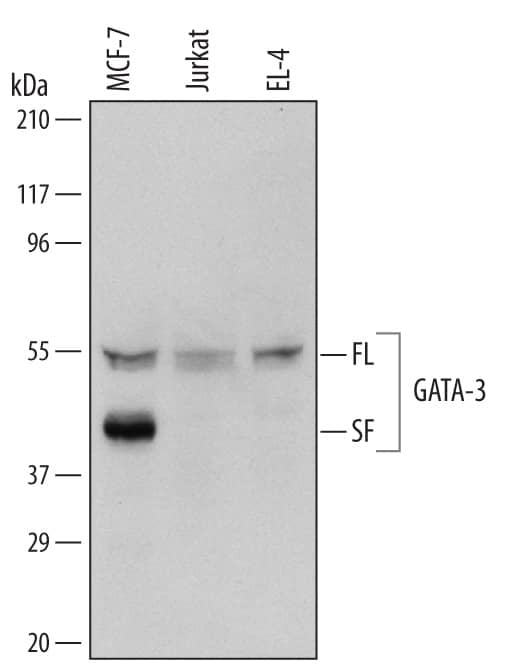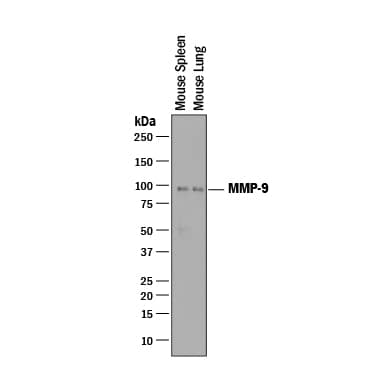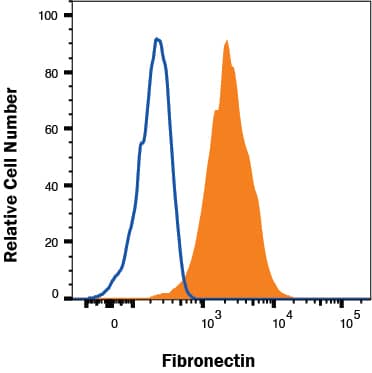Mouse Cyr61/CCN1 Antibody Summary
Asp176-Gly281
Accession # NP_034646
Customers also Viewed
Applications
Please Note: Optimal dilutions should be determined by each laboratory for each application. General Protocols are available in the Technical Information section on our website.
Scientific Data
 View Larger
View Larger
Detection of Mouse Cyr61/CCN1 by Western Blot. Western blot shows lysates of mouse spleenocyte cell, RAW 264.7 mouse monocyte/macrophage cell line, NIH-3T3 mouse embryonic fibroblast cell line, and A20 mouse B cell lymphoma cell line. PVDF membrane was probed with 1 µg/mL of Mouse Cyr61/CCN1 Antigen Affinity-purified Polyclonal Antibody (Catalog # AF4055) followed by HRP-conjugated Anti-Sheep IgG Secondary Antibody (Catalog # HAF016). A specific band was detected for Cyr61/CCN1 at approximately 50 kDa (as indicated). This experiment was conducted under reducing conditions and using Immunoblot Buffer Group 1.
 View Larger
View Larger
Cyr61/CCN1 in Mouse Embryo. Cyr61/CCN1 was detected in immersion fixed frozen sections of mouse embryo (13 d.p.c.) using 15 µg/mL Mouse Cyr61/CCN1 Antigen Affinity-purified Polyclonal Antibody (Catalog # AF4055) overnight at 4 °C. Tissue was stained with the Anti-Sheep HRP-DAB Cell & Tissue Staining Kit (brown; Catalog # CTS019) and counterstained with hematoxylin (blue). Specific labeling was localized to the cytoplasm of muscle cells. View our protocol for Chromogenic IHC Staining of Frozen Tissue Sections.
 View Larger
View Larger
Detection of Mouse Cyr61/CCN1 by Simple WesternTM. Simple Western lane view shows lysates of NIH-3T3 mouse embryonic fibroblast cell line, loaded at 0.2 mg/mL. A specific band was detected for Cyr61/CCN1 at approximately 51 kDa (as indicated) using 10 µg/mL of Sheep Anti-Mouse Cyr61/CCN1 Antigen Affinity-purified Polyclonal Antibody (Catalog # AF4055) followed by 1:50 dilution of HRP-conjugated Anti-Sheep IgG Secondary Antibody (Catalog # HAF016). This experiment was conducted under reducing conditions and using the 12-230 kDa separation system.
Preparation and Storage
- 12 months from date of receipt, -20 to -70 °C as supplied.
- 1 month, 2 to 8 °C under sterile conditions after reconstitution.
- 6 months, -20 to -70 °C under sterile conditions after reconstitution.
Background: Cyr61/CCN1
Cyr61, also known as IGFBP-10 and CCN1, is a 50 kDa secreted matrix- and cell-associated protein that regulates the growth and adhesion of vascular endothelial cells, fibroblasts, and monocytes. Cyr61 interacts with cells that express integrins alpha V beta 3, alpha V beta 5, alpha M beta 2, and alpha 6 beta 1. Cyr61 is cleaved by plasmin within its VWF domain which generates an N-terminal fragment that is not associated with the matrix but retains the ability to induce endothelial cell migration. Cyr61 induces VEGF upregulation, angiogenesis, and tumorigenesis. Between amino acids 176‑281, mouse Cyr61 shares 87% and 97% amino acid sequence identity with human and rat Cyr61, respectively.
Product Datasheets
Citations for Mouse Cyr61/CCN1 Antibody
R&D Systems personnel manually curate a database that contains references using R&D Systems products. The data collected includes not only links to publications in PubMed, but also provides information about sample types, species, and experimental conditions.
13
Citations: Showing 1 - 10
Filter your results:
Filter by:
-
Sildenafil, a phosphodiesterase-5 inhibitor, stimulates angiogenesis and bone regeneration in an atrophic non-union model in mice
Authors: Menger, MM;Bauer, D;Bleimehl, M;Scheuer, C;Braun, BJ;Herath, SC;Rollmann, MF;Menger, MD;Laschke, MW;Histing, T;
Journal of translational medicine
Species: Mouse
Sample Types: Tissue Homogenates
-
Targeting CCN2 protects against progressive non-alcoholic steatohepatitis in a preclinical model induced by high-fat feeding and type 2 diabetes
Authors: Jing Ren, Xiaoyu Wang, Sarah N. Parry, Christine Yee, Mark D. Gorrell, Susan V. McLennan et al.
Journal of Cell Communication and Signaling
-
The TAZ-CAMTA1 Fusion Protein Promotes Tumorigenesis via Connective Tissue Growth Factor and Ras–MAPK Signaling in Epithelioid Hemangioendothelioma
Authors: Shuang Ma, Ryan Kanai, Ajaybabu V. Pobbati, Shuo Li, Kepeng Che, Caleb N. Seavey et al.
Clinical Cancer Research
Species: Mouse
Sample Types: Cell Lysates
Applications: Western Blot -
Senescent hepatic stellate cells promote liver regeneration through IL-6 and ligands of CXCR2
Authors: N Cheng, KH Kim, LF Lau
JCI Insight, 2022-06-16;0(0):.
Species: Mouse
Sample Types: Cell Lysates
Applications: Western Blot -
Resident cardiac macrophages mediate adaptive myocardial remodeling
Authors: Nicole R. Wong, Jay Mohan, Benjamin J. Kopecky, Shuchi Guo, Lixia Du, Jamison Leid et al.
Immunity
-
Amlodipine accelerates bone healing in a stable closed femoral fracture model in mice
Authors: MM Menger, B Merscher, C Scheuer, BJ Braun, SC Herath, MF Rollmann, D Stenger, T Später, T Pohlemann, MD Menger, T Histing
European cells & materials, 2021-05-24;41(0):592-602.
Species: Mouse
Sample Types: Tissue Homogenates
Applications: Western Blot -
Characterization of Matricellular Protein Expression Signatures in Mechanistically Diverse Mouse Models of Kidney Injury
Authors: D Feng, C Ngov, N Henley, N Boufaied, C Gerarduzzi
Sci Rep, 2019-11-13;9(1):16736.
Species: Mouse
Sample Types: Protein
Applications: Western Blot -
Lysophosphatidic acid-induced vascular neointimal formation in mouse carotid arteries is mediated by the matricellular protein CCN1/Cyr61
Authors: Feng Hao, Fuqiang Zhang, Daniel Dongwei Wu, Dong An, Jing Shi, Guohong Li et al.
American Journal of Physiology-Cell Physiology
-
CCN1/CYR61-mediated meticulous patrolling by Ly6Clow monocytes fuels vascular inflammation
Proc Natl Acad Sci USA, 2016-08-01;113(33):E4847-56.
Species: Mouse
Sample Types: Cell Culture Supernates, In Vivo, Whole Cells
Applications: Direct ELISA, IHC-Fr, Neutralization -
CCN1 induces hepatic ductular reaction through integrin alphavbeta(5)-mediated activation of NF-kappaB.
Authors: Kim K, Chen C, Alpini G, Lau L
J Clin Invest, 2015-03-30;125(5):1886-900.
Species: Mouse
Sample Types: Cell Lysates
Applications: Western Blot -
cAMP-induced actin cytoskeleton remodelling inhibits MKL1-dependent expression of the chemotactic and pro-proliferative factor, CCN1
Authors: Aparna Duggirala, Tomomi E. Kimura, Graciela B. Sala-Newby, Jason L. Johnson, Yih-Jer Wu, Andrew C. Newby et al.
Journal of Molecular and Cellular Cardiology
-
The matricellular protein Cyr61 is a key mediator of platelet-derived growth factor-induced cell migration.
Authors: Zhang F, Hao F, An D, Zeng L, Wang Y, Xu X, Cui M
J Biol Chem, 2015-01-26;290(13):8232-42.
Species: Mouse
Sample Types: Whole Cells
Applications: Immunoprecipitation -
Matricellular protein CCN1 promotes regression of liver fibrosis through induction of cellular senescence in hepatic myofibroblasts.
Authors: Kim K, Chen C, Monzon R, Lau L
Mol Cell Biol, 2013-03-18;33(10):2078-90.
Species: Mouse
Sample Types: Tissue Homogenates
Applications: Western Blot
FAQs
No product specific FAQs exist for this product, however you may
View all Antibody FAQsReviews for Mouse Cyr61/CCN1 Antibody
Average Rating: 5 (Based on 2 Reviews)
Have you used Mouse Cyr61/CCN1 Antibody?
Submit a review and receive an Amazon gift card.
$25/€18/£15/$25CAN/¥75 Yuan/¥2500 Yen for a review with an image
$10/€7/£6/$10 CAD/¥70 Yuan/¥1110 Yen for a review without an image
Filter by:
















